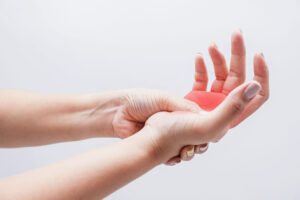อาการ ชา มือ ชา เท้า ในผู้ป่วยโรคหลอดเลือดสมอง

อาการ ชา หรือมีปัญหาการรับรู้ความรู้สึกผิดปกติของร่างกายส่วนใดส่วนหนึ่ง เช่นเดียวกันกับอาการอ่อนแรงที่มักเกิดกับร่างกายครึ่งซีก ซีกใดซีกหนึ่งของผู้ป่วยโรคหลอดเลือดสมอง ซึ่งอาการที่จะกล่าวในบทความนี้ ส่งผลต่อการเคลื่อนไหวที่ปกติ และอาการบาดเจ็บที่เกิดจากอุบัติเหตุที่ไม่รู้ตัว เช่น การกระแทก หรือการรับรู้ของข้อต่อ หากเคลื่อนไหวแล้วไม่รู้ว่ากำลังเคลื่อนไหวอยู่ในท่าทางไหน เช่น กำลังงอเข่า หรือเหยียดเข่าอยู่ สิ่งนี้จะทำให้การเคลื่อนไหวมีท่าทางผิดปกติ เดินผิดปกติ เดินไม่สวย ด้วยเช่นกัน เพราะฉะนั้นการรับความรู้สึกเป็นสิ่งสำคัญ สามารถทำให้เกิดอาการ ชา ได้
การรับความรู้สึกเป็นพื้นฐานการสำรวจโลกภายนอกของร่างกาย การเคลื่อนไหวมีพื้นฐานมาจากการรับความรู้สึกเพื่อรับรู้สิ่งแวดล้อมภายนอกนำไปสู่การเคลื่อนไหว ซึ่งสามารถแบ่งการเคลื่อนไหวใต้อำนาจจิตใจ (voluntary & involuntary movement) ระบบความรู้สึกเริ่มจากการมีสิ่งกระตุ้นร่างกายรับรู้สิ่งกระตุ้นเหล่านั้นผ่าน sensory receptor เกิดการเปลี่ยนสิ่งกระตุ้นเป็นกระแสประสาทผ่านเข้าสู่ sensory pathway เข้าสู่ระบบประสาทส่วนกลางทั้งส่วนที่อยู่ระดับการรับรู้ โดยปกติผิวหนังของคนเราสามารถรับความรู้สึกได้หลายรูปแบบ ไม่ว่าจะเป็นความรู้สึก ร้อน-เย็น, นุ่ม-แข็ง, แหลม-ทู่ ความรู้สึกเหล่านี้จะป้องกันอันตรายที่จะเกิดขึ้นกับผิวหนังเราได้ ความผิดปกติในการรับความรู้สึกมี 2 ลักษณะ คือ ความรู้สึกมากไป หรือความรู้สึกน้อยไป การรับความรู้สึกมากไป คือ มีความไวต่อการรับความรู้สึก ไม่ว่าจะมีอะไรมาสัมผัสถูกผิวหนังเพียงเล็กน้อย ก็จะรู้สึกมากกว่าปกติ ส่วนในกรณีที่การรับความรู้สึกน้อยไปนั้น คือ มีความรู้สึกที่ผิวหนังน้อยลง มักจะเป็นความรู้สึก ชา หรือรู้สึกหนาๆบริเวณผิวหนัง โดยความรู้สึกนี้สามารถเปรียบเทียบได้จากข้างที่มีความรู้สึกปกติ
อาการชาจากพยาธิสภาพที่ระบบประสาทส่วนกลาง หากเนื้อสมองที่ทำหน้าที่รับความรู้สึกขาดเลือดไปเลี้ยงจะส่งผลให้ผู้ป่วย มีอาการดังนี้
- Cerebral cortex เป็นเนื้อสมองที่ทำหน้าที่ควบคุมการรับรู้ความรู้สึกของร่างกายด้านตรงข้าม ถ้ามีพยาธิสภาพเนื้อสมองด้านซ้ายจะทำให้การรับรู้ความรู้สึกของร่างกายซีกขวาผิดปกติ ร่วมกับมีอาการอ่อนแรงของกล้ามเนื้อด้วย
- Internal capsule เป็นเนื้อสมองส่วนที่ทำหน้าที่ควบคุมการรับความรู้สึกบริเวณศีรษะ แขน และขา ด้านตรงข้ามกับรอยโรค ส่วนใหญ่พบร่วมกับอาการอ่อนแรงของกล้ามเนื้อ
- Thalamus เป็นเนื้อสมองส่วนที่ทำหน้าที่ควบคุมการรับความรู้สึกสัมผัสของร่างกายด้านตรงข้าม
- Pons เป็นเนื้อสมองส่วนที่ทำหน้าที่ควบคุมการรับความรู้สึกของใบหน้าซีกเดียวกับพยาธิสภาพ แต่จะมีอาการอ่อนแรงด้านตรงกันข้าม
อาการ ชา จากระบบประสาทส่วนกลางเหล่านี้จะดีขึ้นเมื่อสมองมีการฟื้นตัวในช่วง 6 เดือนแรก โดยการฟื้นฟูในเรื่องของการรับความรู้สึกค่อยๆกรระตุ้นจากง่ายไปยาก จะใช้การกระตุ้นการรับความรู้สึกซ้ำๆ ที่บริเวณผิวหนัง เช่น มือตำแหน่งที่มีอาการ ชา สัมผัสกับสิ่งของที่มีลักษณะพื้นผิวเรียบ ผิวขรุขระร่วมกับการมองและจดจำความรู้สึกไว้ หรือการรับรู้ของข้อต่อ เคลื่อนไหวซ้ำๆ เช่น ฝึกกระตุ้นการรับรู้ของข้อเข่า โดยการงอเข่าเหยียดเข่าร่วมกับการมอง และจดจำความรู้สึกและการเคลื่อนไหว ซึ่งการฟื้นตัวของร่างกายนั้นขึ้นอยู่กับความรุนแรงของรอยโรคด้วย
อ้างอิง Asbury AK, editor. Numbness, Tingling and Sensory loss. In: Kurt J. Isselbacher, Joseph B. Martin, Eugege Braunwald, editors. Harrison’s Principles of Internal Medicine 3rd edition. New York: McGraw-Hill. 1994. p. 133-136. , Daniel von Bornsta dt, Karen Gertz, Nielsen Lagumersindez Denis1, Pierre Seners, Jean-Claude Baron, Matthias Endres. Sensory stimulation in acute stroke therapy. Journal of Cerebral Blood Flow & Metabolism [serial on the internet]. 2018; [cited 2018 Feb 08]. Available from: https://www.ncbi.nlm.nih.gov/pubmed/30073883
Numb hands and feet in patients with stroke
Numbness or having trouble perceiving abnormal sensations in any part of the body. The same is true of the weakness that often occurs on one side of the body. Which side of the stroke patient? which symptoms will be discussed in this article Affects normal movement and injuries resulting from accidental accidents such as bumps or joint awareness. If you move and don’t know what position you’re moving in, such as bending your knees or straightening your knees. This will cause the movement to have an abnormal posture, walk abnormally, and walk unattractively as well. Therefore, receiving sensations is important.
Sensation is the basis for the body’s exploration of the external world. Movement is based on the senses to perceive the external environment leading to movement. which can be divided into movements under the power of the mind (voluntary & involuntary movement). The sensory system starts with having stimuli. The body perceives those stimuli through sensory receptors. The stimulus is changed into nerve impulses that pass through the sensory pathway into the nervous system. The whole central part is at the level of perception. Normally, our skin can sense many different types of sensations. Whether it is hot-cold sensations, soft-hard, sharp-blunt sensations, these sensations will prevent harm that can happen to our skin. There are 2 types of abnormalities in sensory perception: excessive sensations or feeling too little Too much sensation is being sensitive to sensations. No matter how little something comes into contact with the skin. I will feel more than usual. In the case where there is less sensation, there is less sensation in the skin. Often it is a feeling of numbness. or feel thick around the skin This feeling can be compared to the side that has a normal feeling.